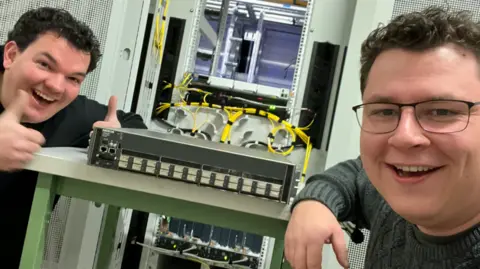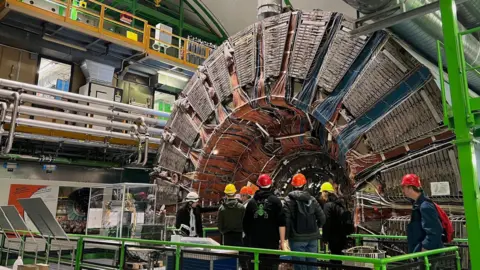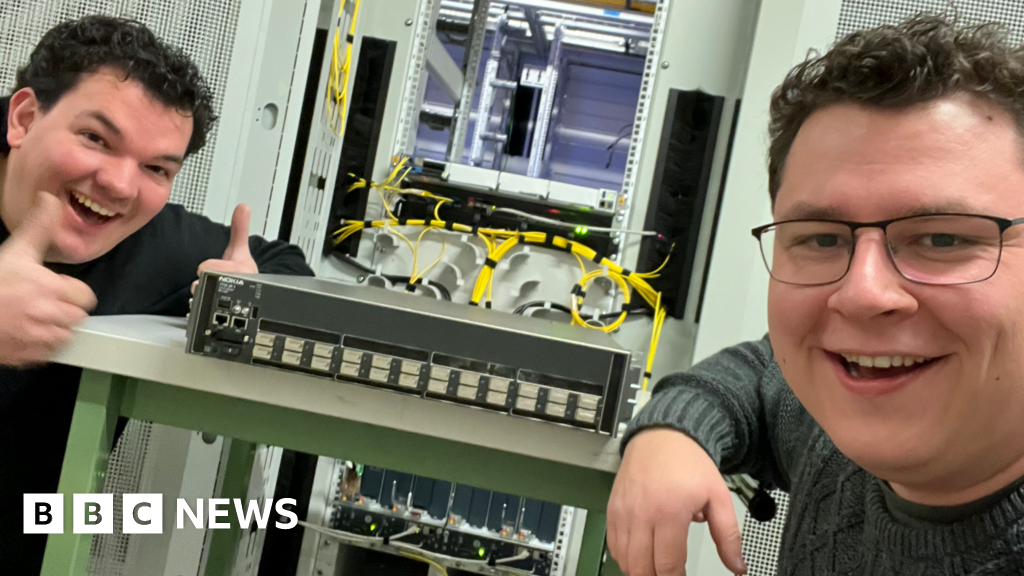By Chris Baraniuk, Technology Reporter
 surf
surfAs IT updates go, this was about as nerve-wracking as things can get.
In February, deep inside a warehouse at Cern, the Swiss home of the Large Hadron Collider (LHC) – the world’s biggest science experiment – two network engineers held their breath. And pressed a button.
Suddenly, text on a black background flashed up on a screen in front of them. It had worked. “There was high-fiving involved,” recalls Joachim Opdenakker at SURF, a Dutch IT association that works for educational and research institutions. “It was super-cool to see.”
He and his colleague Edwin Verheul had just set up a new data link between the LHC in Switzerland and data storage sites in The Netherlands.
A data link that could reach speeds of 800 gigabits per second (Gbps) – or more than 11,000 times the average UK home broadband speed. The idea is to improve scientists’ access to the results of LHC experiments.
A subsequent test in March using special equipment on loan from Nokia proved the desired speeds were achievable.
“This transponder that Nokia uses, it’s like a celebrity,” says Mr Verheul, explaining how the kit is booked up for use at various locations in advance. “We had limited time to do tests. If you have to postpone a week, then the transponder is gone.”
This amount of bandwidth, approaching one terabit per second, is extremely fast but some subsea cables are a few hundred times faster still – they use multiple fibre strands to achieve such speeds.
 Nokia & Surf
Nokia & SurfIn labs around the world, networking experts are coming up with fibre optic systems capable of pushing data around even more rapidly than this. They are reaching extraordinary speeds of many petabits per second (Pbps), or 300 million times the average UK home broadband connection.
This is so fast that one can barely imagine how people will use such bandwidth in the future. But engineers are wasting no time in proving that it is possible. And they only want to go faster.
The duplex cable (with cores that either send or receive) from Cern to data centres in The Netherlands is just shy of 1,650km (I,025 miles) long, snaking from Geneva to Paris, then Brussels, and finally Amsterdam. Part of the challenge in reaching 800 Gbps was in beaming pulses of light such a long way. “Due to the distance, the power levels of that light decrease, so you have to amplify it at different locations,” explains Mr Opdenakker.
Every time one tiny subatomic particle smashes into another during experiments at the LHC, the impact generates staggering volumes of data – about one petabyte per second. That’s enough to fill 220,000 DVDs.
This is slimmed down for storage and study, but still requires hefty amounts of bandwidth. Plus, with an upgrade due by 2029, the LHC expects to produce even more scientific data than it does today.
“The upgrade increases the number of collisions by at least a factor of five,” says James Watt, senior vice president and general manager of optical networks at Nokia.
A time when 800 Gbps seems slow may not be far away, however. In November, a team of researchers in Japan broke the world speed record for data transmission when they reached an astonishing 22.9 Pbps. That’s enough bandwidth to supply every single person on the planet, and then a couple billion more, with a Netflix stream, says Chigo Okonkwo at Eindhoven University of Technology, who was involved in the work.
In this case, a meaningless but huge stream of pseudorandom data was beamed over 13km of coiled fibre optic cable in a lab setting. Dr Okonkwo explains that the integrity of the data is analysed post-transfer to confirm it was sent as quickly as reported without accumulating too many errors.
He also adds that the system he and colleagues used relied on multiple cores – a total of 19 cores inside one fibre cable. This is a new type of cable unlike the standard ones that connect many people’s home to the internet.
But older fibre is expensive to dig up and replace. Extending its lifetime is useful, argues Wladek Forysiak at Aston University in the UK. He and colleagues have recently achieved speeds of around 402 terabits per second (Tbps) along a 50km-long optical fibre with just one core. That’s about 5.7 million times faster than the average UK home broadband connection.
“I think it’s a world best, we don’t know of any results that are better than that,” says Prof Forysiak. Their technique relies on using more wavelengths of light than usual when flashing data down an optical line.
For this they use alternative forms of the electronic equipment that sends and receives signals over fibre optic cables but such a setup could be easier to install than replacing thousands of kilometres of the cable itself.
Activities in the so-called metaverse might one day require extreme bandwidth, suggests Martin Creaner, director general of the World Broadband Association. His organisation expects home broadband connections to reach up to 50 Gbps by 2030.
But reliability may be even more important than speed for some applications. “For remote robotic surgery across 3,000 miles… you absolutely do not want any scenario where the network goes down,” says Mr Creaner.
Dr Okonkwo adds that training AI will increasingly require moving huge datasets around. The faster this can be done, the better, he argues.
And Ian Phillips, who works alongside Prof Forysiak, says bandwidth tends to find applications once it is available: “Humanity finds a way of consuming it.”
 TeleGeography
TeleGeographyAlthough multiple petabits per second is far beyond what today’s web users need, Lane Burdette, research analyst at TeleGeography, a telecoms market research firm, says it is striking how quickly demand for bandwidth is growing – currently, at around 30% year-on-year on transatlantic fibre optic cables.
Content provision – social media, cloud services, video streaming – is eating up far more bandwidth than before, she notes: “It used to be like 15% of international bandwidth in the early 2010’s. Now it’s up to three quarters, 75%. It’s absolutely massive.”
In the UK, there is still a long way to go to improve internet speeds. Many people cannot access sufficiently fast broadband at home.
Andrew Kernahan, head of public affairs at the Internet Service Providers Association says most home users can now access gigabit per second speeds.
However, only about a third of broadband customers are signing up for such technology. There’s no “killer app” at the moment that really requires it, says Mr Kernahan. This might change as more and more TV is consumed via the internet, for example.
“There’s definitely a challenge to get the message out there and make people more aware of what they can do with the infrastructure,” he says.



















.png)


Discussion about this post